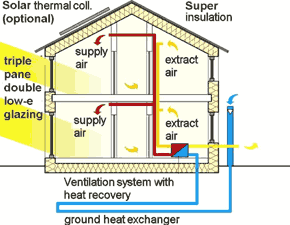Standards
There are a confusing variety of standards for ecological building, and in particular for energy efficiency standards. We work particularly with the following standards, which we believe to be the most relevant.
Passivhaus
Since the 1973 Oil Crisis the major developments in low-energy housing standards have taken place in Canada, Scandinavia and Germany. The Passivhaus standard, a German-Swedish concept, was developed in Germany and tested in Austria, Germany, France, Sweden and Switzerland, with European Union support. It is one of the most advanced standards not just in terms of energy savings and carbon emissions, but also because the energy performance of the building can be reliably modelled during the design stage using computer software.
Passivhaus buildings (Passive Houses) are so called because they capture use and recycle the 'passive' heat already in the building - the heat generated by the activity of the people, from the use of electrical appliances, and from the sun entering the windows - rather than 'actively' heating the building. Incredible though it may seem, they do this so well that they can be built without conventional central heating, even in the colder climate of northern Europe.
In order to achieve this Passive Houses are built with extra thick insulation, and they are highly sealed to prevent air leaking between the inside and the outside of the building. They are also fitted with special super-insulated triple glazed windows and doors. These measures keep the heat in during the winter, and out during the summer. Because the building is sealed when the windows are closed, the air within the building is changed using a low-speed central ventilation unit. This recycles around 80% of the heat in the outgoing air to warm the incoming fresh air. On the coldest days the air can be warmed further using a special heater in the air ducts, if necessary, to maintain a comfortable temperature.
In addition, Passive Houses use low-energy lighting and high-efficiency domestic appliances in order to minimise overall energy use.
As a result of these techniques, Passive Houses use much less energy than conventional homes, generate much lower carbon emissions, and also have much lower energy bills. Such buildings will also be essential to achieve the Governments carbon reduction targets. While new to the British market, the Passivhaus standard is the leading standard in Europe, where several thousand homes have been built since the beginning of the decade.
AECB Gold Energy Standard™
The Gold Energy Standard™, published by the Association of Environment Conscious Building, is essentially a British enhancement of the Passivhaus standard. The most significant differences are that 70% of the hot water must be solar heated, that microgeneration technologies must produce enough electricity to make the lighting, the ventilation unit and by domestic appliances carbon-neutral, and that electrical heating is not permitted.
AECB Silver Energy Standard™
While still well in advance of normal British Building Regulations requirements, the AECB Silver Energy Standard™, is not as demanding as the Passivhaus. Instead it is closer to the earlier German Niedrigenergiehaus (Low Energy House) standard.
Energy Performance Certificates
Although a means of measuring the energy efficiency of homes, rather than a performance standard, from June 2007 every home needs an Energy Performance Certificate before it can be sold. It is expected that in the future the ratings will have an influence on property prices.
Code for Sustainable Homes
In contrast to the previous standards, the Government's new Code for Sustainable Homes, launched at the end of 2006, takes into account a wide range of ecological features. Under this scheme, homes are given a 'star rating' from Level 1 for the least sustainable, to Level 6 for the most sustainable.
The overall star rating is based on evaluating 34 different factors, from carbon emissions, water use and composing, to daylighting, the provision of washing lines, and the building's ecological footprint. Current 'exemplary performance' broadly corresponds to Level 4, with Level 6 requiring high performance across all categories, including producing zero carbon emissions.
The Passivhaus standard, a German-Swedish concept, was developed in Germany and tested in Austria, Germany, France, Sweden and Switzerland, with European Union support.
It is one of the most advanced standards not just in terms of energy savings and carbon emissions, but also because the energy performance of the building can be reliably modelled during the design stage using computer software.

